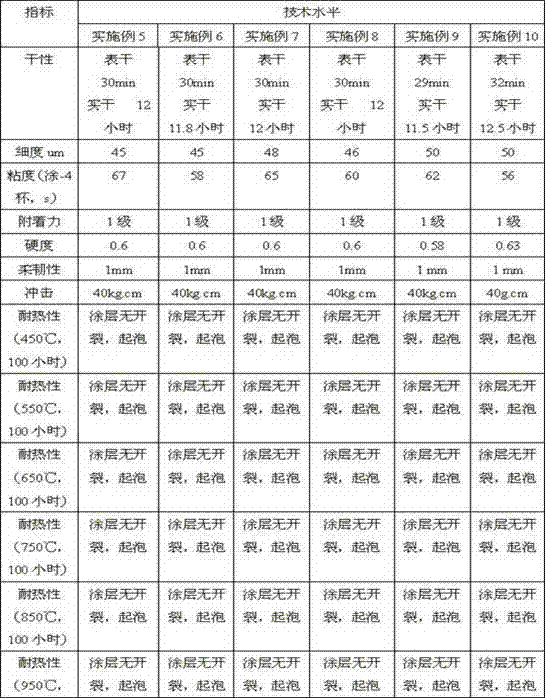Gradient organic silicon heat-resisting coating
A technology of heat-resistant coatings and silicones, which is applied in the direction of coatings, etc., can solve the problems of poor self-drying performance and narrow heat-resistant temperature range of coatings, and achieve the effects of increased heat-resistant temperature, good anti-corrosion performance, and good adhesion performance
- Summary
- Abstract
- Description
- Claims
- Application Information
AI Technical Summary
Problems solved by technology
Method used
Image
Examples
Embodiment 1
[0020] The synthesis process step of epoxy modified silicone resin solution of the present invention is as follows:
[0021] 1) Synthesis of organosilicon intermediates: Take 15kg of phenyltrichlorosilane, 8kg of dimethyldichlorosilane, 35kg of xylene, 30kg of ethanol, and 12kg of deionized water; Add 1 / 2 xylene to the hydrolysis kettle, drop the mixture of phenyltrichlorosilane, dimethyldichlorosilane and the remaining 1 / 2 xylene from the high position tank, and control the flow rate at 5.5 hours (at 5-6 within hours) after the dropwise addition, the hydrolysis temperature is controlled at 22°C (all within the range of 20-25°C), keep stirring for half an hour after the dropwise addition, and stand still for 3.5 hours (all within the range of 3-4 hours ), so that the chlorine ions and hydrogen ions in the above raw materials combine to generate hydrochloric acid and precipitate in the lower part of the hydrolysis kettle; let go of the acid water in the lower part of the hydrol...
Embodiment 2
[0024] The synthesis process step of epoxy modified silicone resin solution of the present invention is as follows:
[0025] 1) Synthesis of organosilicon intermediates: Take 20kg of phenyltrichlorosilane, 10kg of dimethyldichlorosilane, 40kg of xylene, 35kg of ethanol, and 15kg of deionized water; Add 1 / 2 xylene to the hydrolysis kettle, drop the mixed solution of 1-phenyltrichlorosilane, dimethyldichlorosilane and the remaining 1 / 2 xylene from the high position tank, control the flow rate at 6 hours to complete the dropwise addition, and hydrolyze The temperature is controlled at 25°C. After the dropwise addition, keep stirring for half an hour, and stand still for 4 hours, so that the chloride ions and hydrogen ions in the above raw materials combine to form hydrochloric acid and precipitate in the lower part of the hydrolysis kettle; let go of the acid water in the lower part of the hydrolysis kettle, and add Ionized water (dosage is not included in the formula), washed wi...
Embodiment 3
[0028] The synthesis process step of epoxy modified silicone resin solution of the present invention is as follows:
[0029] 1) Synthesis of organosilicon intermediates: Take 20kg of phenyltrichlorosilane, 10kg of dimethyldichlorosilane, 40kg of xylene, 35kg of ethanol, and 15kg of deionized water; Add 1 / 2 xylene to the hydrolysis kettle, drop the mixed solution of 1-phenyltrichlorosilane, dimethyldichlorosilane and the remaining 1 / 2 xylene from the high position tank, control the flow rate at 6 hours to complete the dropwise addition, and hydrolyze The temperature is controlled at 25°C. After the dropwise addition, keep stirring for half an hour, and stand still for 4 hours, so that the chloride ions and hydrogen ions in the above raw materials combine to form hydrochloric acid and precipitate in the lower part of the hydrolysis kettle; let go of the acid water in the lower part of the hydrolysis kettle, and add Ionized water (dosage is not included in the formula), washed wi...
PUM
 Login to View More
Login to View More Abstract
Description
Claims
Application Information
 Login to View More
Login to View More - R&D Engineer
- R&D Manager
- IP Professional
- Industry Leading Data Capabilities
- Powerful AI technology
- Patent DNA Extraction
Browse by: Latest US Patents, China's latest patents, Technical Efficacy Thesaurus, Application Domain, Technology Topic, Popular Technical Reports.
© 2024 PatSnap. All rights reserved.Legal|Privacy policy|Modern Slavery Act Transparency Statement|Sitemap|About US| Contact US: help@patsnap.com








